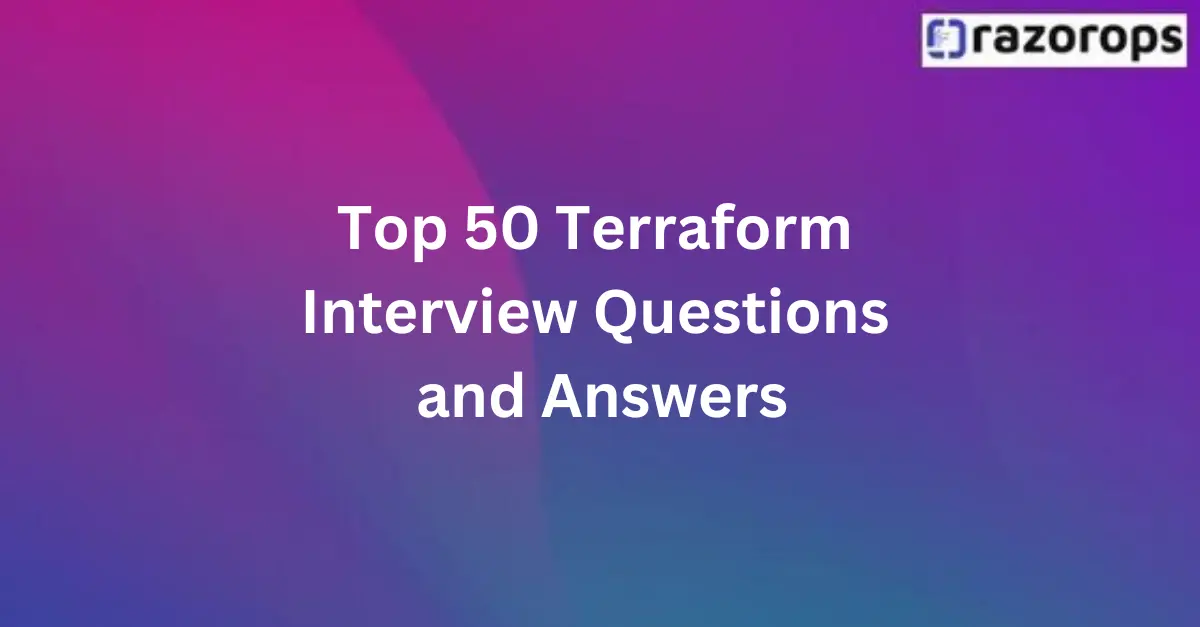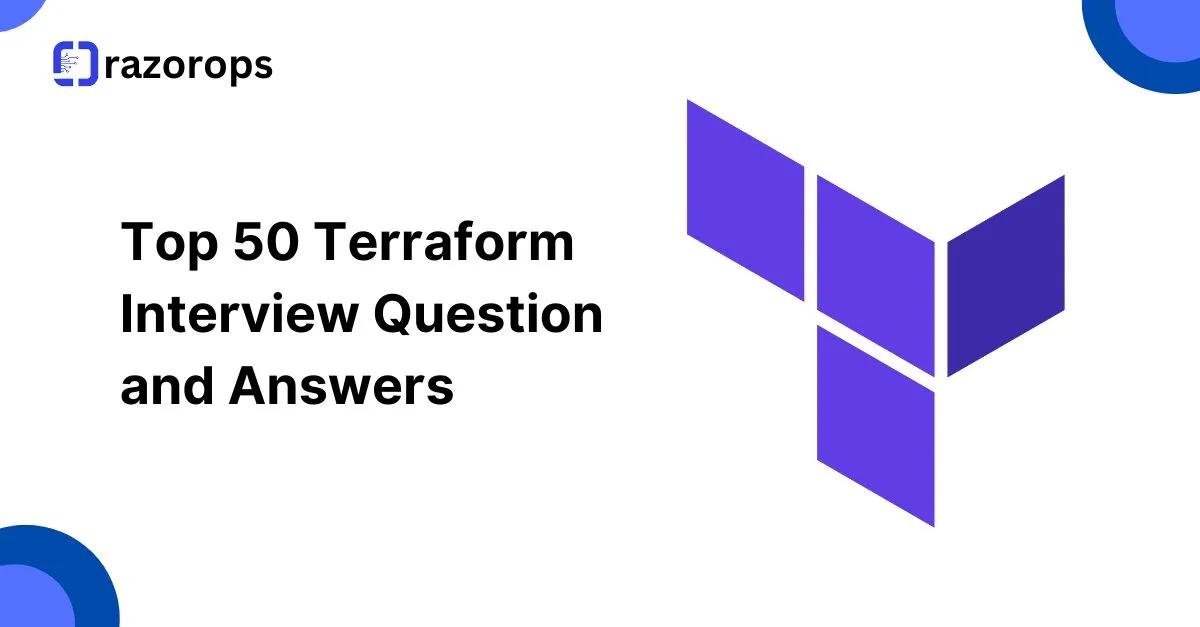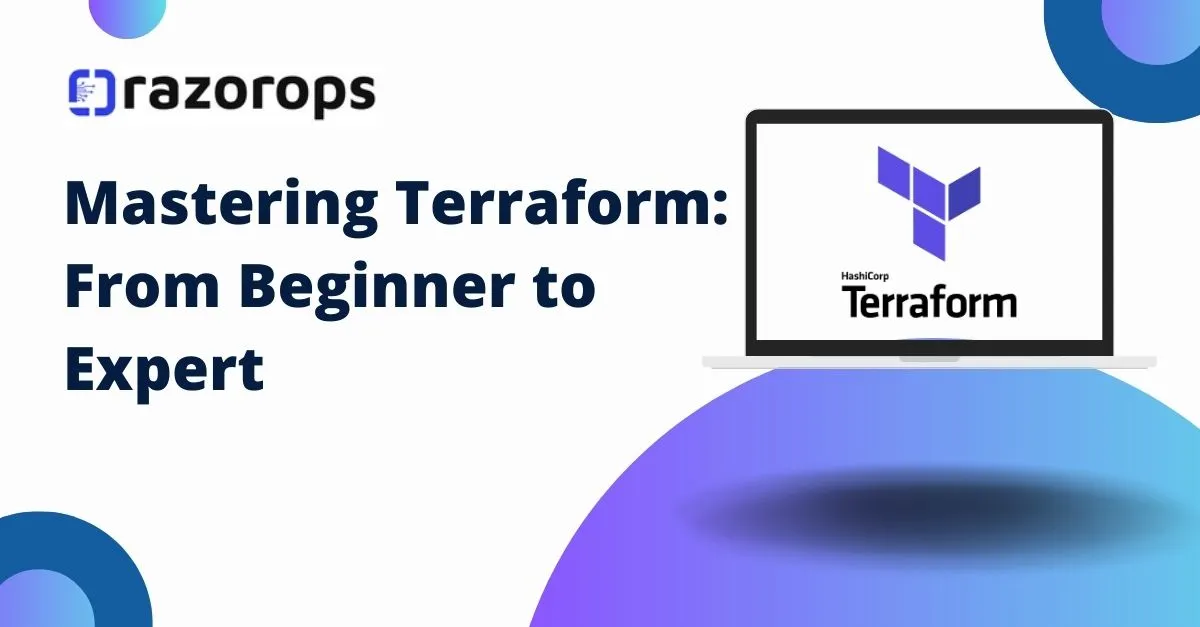Top 50 Terraform Interview Questions and Answers

Top 50 Terraform Interview Questions and Answers
1. What is Terraform?
Terraform is an open-source infrastructure as code (IaC) tool created by HashiCorp. It allows users to define and provision infrastructure using a high-level configuration language.
2. What are the main features of Terraform?
Infrastructure as code, execution plans, resource graph, change automation.
3. What is Infrastructure as Code (IaC)?
IaC is a process of managing and provisioning computing infrastructure through machine-readable configuration files, rather than physical hardware configuration or interactive configuration tools.
4. What is a Terraform provider?
A provider is a plugin that allows Terraform to manage resources on a specific platform (e.g., AWS, Azure, Google Cloud).
5. What is a Terraform module?
A module is a container for multiple resources that are used together. It’s a way to organize and encapsulate related pieces of infrastructure.
6. What are Terraform state files?
State files track the current state of the infrastructure managed by Terraform. They help Terraform map real-world resources to your configuration.
7. What is the purpose of the terraform in it command?
terraform in it initializes a working directory containing Terraform configuration files, downloading the necessary provider plugins.
8. What does the terraform plan command do?
terraform plan creates an execution plan, showing what actions Terraform will take to achieve the desired state as specified in the configuration files.
9. What does the terraform apply command do?
terraform apply applies the changes required to reach the desired state of the configuration.
10. What does the terraform destroy command do?
terraform destroy removes all the resources managed by the configuration.
11. What is a Terraform backend?
A backend determines how state is loaded and how operations are executed. Examples include local file storage, AWS S3, and HashiCorp Consul.
12. Explain the concept of “Terraform providers”.
Providers are plugins that enable interaction with cloud providers, SaaS providers, and other APIs. Each provider has its own set of resources and data sources.
13. How do you handle sensitive data in Terraform?
Use variables marked as sensitive, environment variables, or external secrets management tools like HashiCorp Vault.
14. What are Terraform workspaces?
Workspaces allow for multiple state files to be used within a single configuration directory, useful for managing different environments (e.g., dev, staging, production).
15. What is the difference between terraform taint and terraform untaint?
terraform taint marks a resource for recreation on the next apply, while terraform untaint reverses this marking.
16. What is the purpose of the terraform refresh command?
terraform refresh updates the state file with the actual infrastructure.
17. What are data sources in Terraform?
Data sources allow you to fetch data from other systems to use in your Terraform configurations.
18. How can you import existing infrastructure into Terraform?
Use the terraform import command to bring existing resources into Terraform’s state management.
19. How do you upgrade Terraform versions?
Update the Terraform binary and then run terraform init -upgrade to upgrade provider versions.
20. What are Terraform output values?
Outputs are used to display information about the resources created by Terraform and can be queried and used as inputs in other configurations.
21. How do you use Terraform with CI/CD pipelines?
Integrate Terraform commands within your CI/CD workflows to automate infrastructure changes, using tools like Jenkins, GitLab CI, or GitHub Actions.
22. What is a resource graph in Terraform?
A resource graph is a visual representation of the dependencies between resources in a configuration.
23. How do you manage multiple environments in Terraform?
Use workspaces, directory structure, and environment-specific variables.
24. What is a local-exec provisioner?
The local-exec provisioner runs a command locally on the machine running Terraform.
25. What is a remote-exec provisioner?
The remote-exec provisioner runs a command on the remote resource being provisioned.
26. What are Terraform’s limitations?
Potential state file conflicts, limited support for certain providers, and complexity in managing large-scale infrastructure.
27. How do you perform blue-green deployments with Terraform?
Create two sets of infrastructure, switch traffic between them, and manage DNS or load balancers.
28. How do you handle dependencies in Terraform?
Terraform automatically handles dependencies through resource relationships defined in configurations.
29. What is the use of the terraform fmt command?
terraform fmt formats Terraform configuration files to a canonical format and style.
30. How can you extend Terraform functionality?
Write custom providers or modules, use provisioners, or leverage the Terraform plugin SDK.
31. What are Terraform dynamic blocks?
Dynamic blocks allow for complex resource configurations by dynamically constructing nested blocks.
32. How do you deal with state file locking?
Use a backend that supports state locking (e.g., AWS S3 with DynamoDB for locking) to prevent concurrent state changes.
33. What are the benefits of using remote backends?
Centralized state management, locking, versioning, and collaboration.
34. What is the purpose of the terraform validate command?
terraform validate checks the syntax and internal consistency of configuration files.
35. What are depends_on in Terraform?
The depends_on meta-argument explicitly specifies resource dependencies.
36. Describe a time when you had to troubleshoot a Terraform configuration issue.
(Answer should include problem identification, steps taken to resolve, and outcome).
37. How do you ensure the reliability and consistency of Terraform deployments?
Use version control, code reviews, automated testing, and state file management practices.
38. What is your approach to managing Terraform state files in a team environment?
Use remote backends, state locking, and CI/CD pipelines to manage and protect state files.
39. Can you explain a complex Terraform project you worked on?
(Answer should detail the project’s scope, challenges faced, and solutions implemented).
40. How do you handle breaking changes in Terraform provider upgrades?
Review provider changelogs, test changes in a separate environment, and update configurations accordingly.
41. What is the difference between Terraform and other IaC tools like Ansible, Chef, or Puppet?
Terraform is declarative and focuses on infrastructure provisioning, while others are more procedural and often used for configuration management.
42. How does Terraform handle rollbacks?
Terraform does not have built-in rollback; you need to manually revert to a previous state or configuration.
43. What is the terraform graph command used for?
terraform graph generates a DOT format graph that visualizes the dependency graph.
44. Explain the role of count and for_each in Terraform.
count allows you to create multiple instances of a resource; for_each provides more control and can create multiple instances based on a map or set.
45. How do you handle secrets in Terraform?
Use environment variables, encrypted files, or secret management tools like HashiCorp Vault.
46. What is the use of the terraform console command?
terraform console provides an interactive console for evaluating expressions in your configuration.
47. How do you debug Terraform issues?
Use terraform plan, terraform apply, and logging/debugging flags. Review state files and logs for detailed insights.
48. What are the different ways to pass variables in Terraform?
Through .tfvars files, environment variables, command-line flags, or directly in the configuration file.
49. How do you handle large Terraform configurations?
Break them into modules, use workspaces, and organize files logically.
50. What is the use of terraform workspace?
Workspaces allow you to manage multiple state files for different environments within a single configuration directory.



